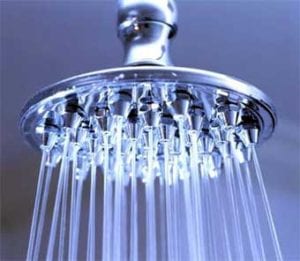Tankless Water Heating
 Imagine the days when, if you needed hot water, you put a kettle or pot (or several of each) on the stove and heated as much water as you needed. Of course, you may also have needed to add some fuel to the fire, assuming it was already going. I suspect this was a strong motivator to be conservative in our use of hot water!
Imagine the days when, if you needed hot water, you put a kettle or pot (or several of each) on the stove and heated as much water as you needed. Of course, you may also have needed to add some fuel to the fire, assuming it was already going. I suspect this was a strong motivator to be conservative in our use of hot water!
As our domestic appliances advanced, we developed a hot water storage tank, where we could use an appropriately-sized storage tank to meet the demands of the home or business. The water in the tank is kept heated to a preset temperature, usually around 120 degrees for normal use, using either an electric heating element or a burner fueled by natural gas. As water is drawn from the tank for showers or washing, fresh cold water is drawn into the tank and the whole tank is heated to maintain that set temperature. Tanks vary in size, usually from 40 to 60 gallons, but for larger homes larger or multiple tanks may be used.
Using cheap energy, this is a perfectly acceptable way of doing things. However, this keeps a set amount of water heated to satisfy intermittent demand. So even if you don’t use the hot water, you’re still keeping it hot, and that requires energy. You can minimize your losses by installing an insulating jacket on the water heater and hot water pipes, and turn down the water heater when you’re away on vacation. But a more ideal solution is to use a demand water heater, which only heats water as you need it.
Demand water heaters, also called instantaneous or tankless water heaters, are more expensive than traditional hot water tanks, with prices typically ranging from $1,000-$1,500 for the equipment vs. around $500 for a hot water tank. However, the installation costs can be significantly higher – around $2,000 or more vs. about $300 for a hot water tank. The main reason for this is that when you replace your hot water tank, the new one can be installed right in place of the old one with little additional plumbing work. The tankless unit, which hangs on a wall and takes up significantly less space, will need to have more pipework done to get it properly installed.
In my home, I had a 50 year-old boiler for my radiant heating system and a 25 year-old hot water tank. Both appliances work, but not efficiently. My boiler was only 60% efficient, with much of the heat going out the flue. So when I began looking at high-efficiency boilers to save on my heating costs, I found a dual-purpose unit that would not only heat the water for my radiant heating system, but also my domestic hot water. The Quietside Dual Purpose Water Heater was comparable in cost to other boilers, so I effectively got the tankless water heater for no additional cost!
The Quietside comes in three capacities – 99, 120 and 199 kBtu/h. Since we use low-flow shower heads and have a relatively small family of four, we were able to get by with the smallest unit. We used to keep our hot water tank at 120°, but increased the flow rate to three gallons per minute by lowering the temperature to 110°, which is still plenty warm for a shower. The water does not actually get hot instantaneously, as implied – it takes a few extra seconds for the water to be heated. But if sized properly, you should never run out of hot water.
Unique Heating and Cooling is an authorized Quietside dealer and did a nice job installing my system. This solution is not for everyone, but if you’re replacing a boiler it is definitely worth considering. If you’re building a new home with radiant heat, you’re another good candidate. You might also consider locating the unit in close proximity to the bathrooms to minimize heat losses in long pipe runs.
Thankfully we live in a time when we can simply turn a handle and get fresh hot water. We can also be grateful that we live in a time when this can be done with high efficiency!
This was published in the Going Green section of the November 2011 issue of Spirit Seeker magazine. See the related Success Story that was published in the December issue.
Postscript: In comparing our gas bills since I wrote this story, and am pleased to report substantial savings. Our heating bills were about half of what they were the same period last year. Factoring the slightly colder weather last year, the net effect was about 30%. In the off-season where we’ve just using gas to heat water and cook, our gas bill continues to be about half of what it usually is (10-12 therms/month vs. 20-25). In fact, $30 gas bill was $20 for the monthly service charge and only $10 for the gas!
